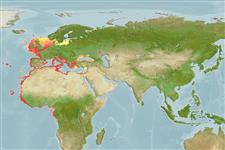Пластиножаберные (акулы и скаты) (sharks and rays) >
Myliobatiformes (Stingrays) >
Dasyatidae (Stingrays) > Dasyatinae
Etymology: Dasyatis: Greek, dasys = rough, dense (Ref. 45335).
More on author: Linnaeus.
Environment: milieu / climate zone / depth range / distribution range
экология
морской; солоноватоводный демерсальный; пределы глубины 5 - 200 m (Ref. 6808), usually 20 - 35 m (Ref. 27000). Subtropical; 61°N - 17°S, 32°W - 42°E
East Atlantic and the Mediterranean and Black Sea, from the North Sea to Angola.
Length at first maturity / Size / Вес / Возраст
Maturity: Lm 54.3, range 41 - ? cm
Max length : 69.5 cm WD самец/пол неопределен; (Ref. 123699); наибольший вес (опубликованные данные): 14.6 kg (Ref. 86713)
A coastal species, which enters coastal lagoons, shallow bays and estuaries (Ref. 81259). Found over sandy and muddy bottoms, sometimes near rocky reefs (Ref. 12951). Feeds on bottom fishes, crustaceans and mollusks. Ovoviviparous, gestation period about 4 months and 4-7 young are produced. Wings marketed smoked, dried-salted, and also used for fishmeal and oil. Harmful to shellfish banks; dangerous to bathers and fishers due to its poisonous spine. Barbed poison spine is a modified denticle that can be 35cm long, shed occasionally and replaced (Ref. 35388). Maximum reported width about 150 cm (Ref. 81259).
Exhibit ovoviparity (aplacental viviparity), with embryos feeding initially on yolk, then receiving additional nourishment from the mother by indirect absorption of uterine fluid enriched with mucus, fat or protein through specialised structures (Ref. 50449). Distinct pairing with embrace (Ref. 205).
Bauchot, M.-L., 1987. Raies et autres batoides. p. 845-886. In W. Fischer, M.L. Bauchot and M. Schneider (eds.) Fiches FAO d'identificationpour les besoins de la pêche. (rev. 1). Mèditerranée et mer Noire. Zone de pêche 37. Vol. II. Commission des Communautés Européennes and FAO, Rome. (Ref. 3261)
Статус Красного Списка МСОП (Ref. 130435: Version 2024-2)
Использование человеком
рыболовство: коммерческий; объект спортивного рыболовства: да
дополнительная информация
инструменты
Специальные отчеты
Скачать в формате XML
ресурсы в Интернет
Estimates based on models
Preferred temperature (Ref.
123201): 9.7 - 26.1, mean 12.2 °C (based on 352 cells).
Phylogenetic diversity index (Ref.
82804): PD
50 = 0.5002 [Uniqueness, from 0.5 = low to 2.0 = high].
Bayesian length-weight: a=0.00389 (0.00302 - 0.00501), b=3.10 (3.03 - 3.17), in cm total length, based on LWR estimates for this species (Ref.
93245).
Trophic level (Ref.
69278): 3.6 ±0.5 se; based on diet studies.
устойчивость к внешним воздействиям (Ref.
120179): очень низкий, минимальное время удвоения популяции более 14 лет (Fec=4-7).
Fishing Vulnerability (Ref.
59153): Very high vulnerability (78 of 100).
Climate Vulnerability (Ref.
125649): Moderate to high vulnerability (55 of 100).
Nutrients (Ref.
124155): Calcium = 14.1 [1.7, 252.0] mg/100g; Iron = 0.696 [0.063, 8.002] mg/100g; Protein = 21.3 [18.7, 24.0] %; Omega3 = 0.263 [0.085, 0.750] g/100g; Selenium = 22 [4, 104] μg/100g; VitaminA = 7.14 [0.64, 75.50] μg/100g; Zinc = 0.591 [0.039, 6.718] mg/100g (wet weight);
